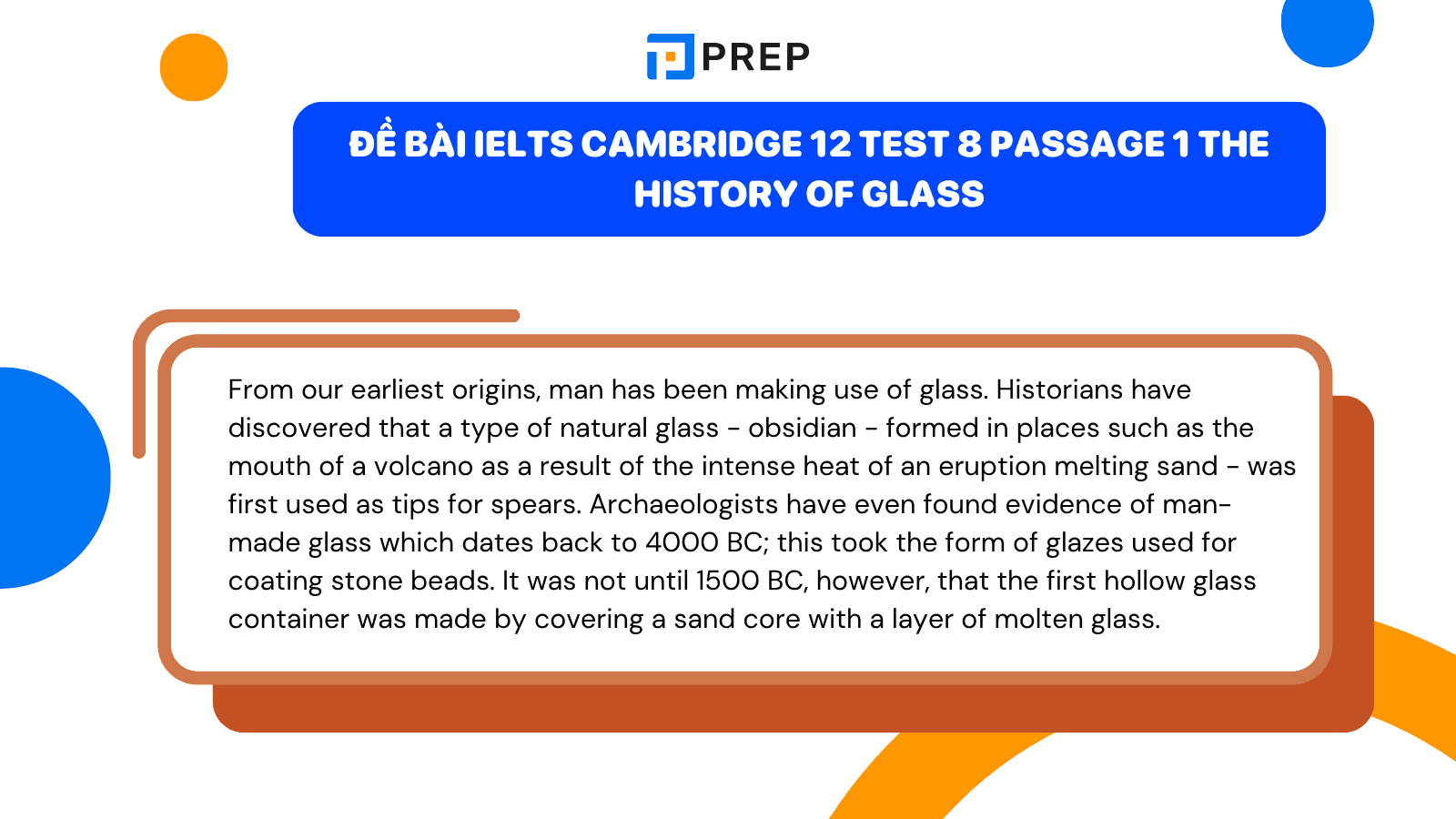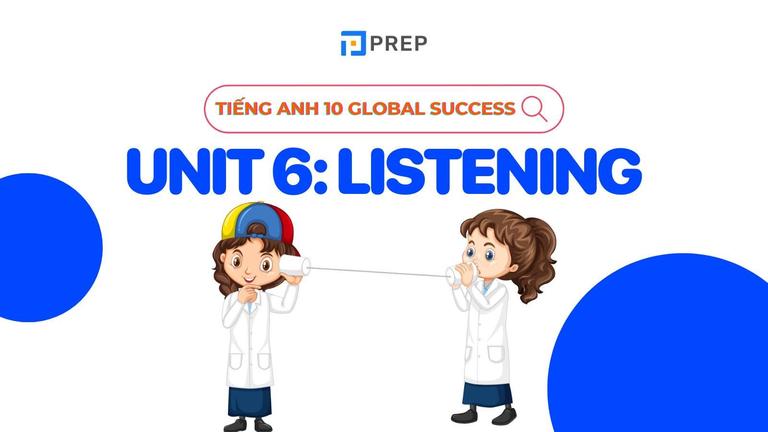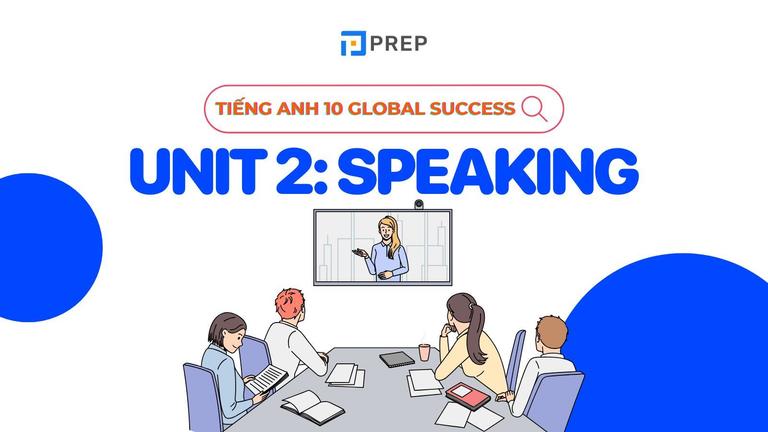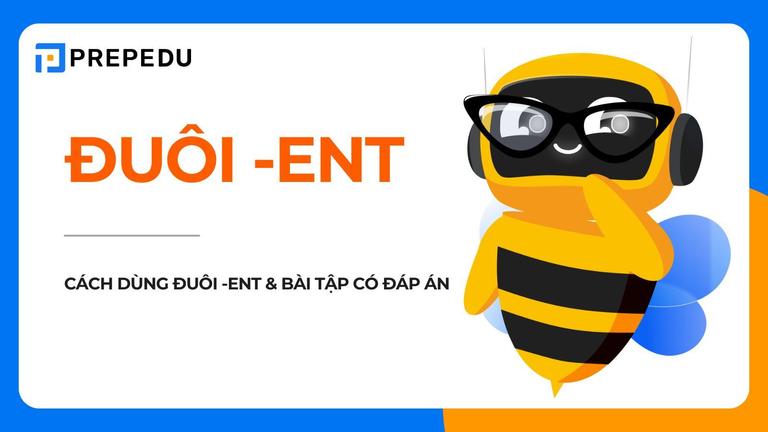Đề bài và đáp án chi tiết IELTS Cambridge 12 test 8 passage 1 The history of glass
Bài đọc Cambridge IELTS 12 Test 8, Passage 1 The History of Glass là bài đọc thú vị về lịch sử của thủy tinh. Bài viết dưới đây Prep sẽ tổng hợp đề bài, phân tích từng câu hỏi, và giải thích cụ thể đáp án để hiểu rõ cách ra đề và rèn kỹ năng định vị thông tin trong Reading. Cùng tham khảo để có thêm tư liệu luyện thi IELTS chất lượng nhé!

I. Đề bài IELTS Cambridge 12 test 8 passage 1 The history of glass
Đọc đề bài IELTS Cambridge 12 test 8 passage 1 The history of glass:
The History of Glass
From our earliest origins, man has been making use of glass. Historians have discovered that a type of natural glass - obsidian - formed in places such as the mouth of a volcano as a result of the intense heat of an eruption melting sand - was first used as tips for spears. Archaeologists have even found evidence of man-made glass which dates back to 4000 BC; this took the form of glazes used for coating stone beads. It was not until 1500 BC, however, that the first hollow glass container was made by covering a sand core with a layer of molten glass.
Glass blowing became the most common way to make glass containers from the first century BC. The glass made during this time was highly coloured due to the impurities of the raw material. In the first century AD, methods of creating colourless glass were developed, which was then tinted by the addition of colouring materials. The secret of glass making was taken across Europe by the Romans during this century. However, they guarded the skills and technology required to make glass very closely, and it was not until their empire collapsed in 476 AD that glass-making knowledge became widespread throughout Europe and the Middle East. From the 10th century onwards, the Venetians gained a reputation for technical skill and artistic ability in the making of glass bottles, and many of the city's craftsmen left Italy to set up glassworks throughout Europe.
A major milestone in the history of glass occurred with the invention of lead crystal glass by the English glass manufacturer George Ravenscroft (1632 - 1683). He attempted to counter the effect of clouding that sometimes occurred in blown glass by introducing lead to the raw materials used in the process. The new glass he created was softer and easier to decorate, and had a higher refractive index, adding to its brilliance and beauty, and it proved invaluable to the optical industry. It is thanks to Ravenscroft's invention that optical lenses, astronomical telescopes, microscopes and the like became possible.
In Britain, the modern glass industry only really started to develop after the repeal of the Excise Act in 1845. Before that time, heavy taxes had been placed on the amount of glass melted in a glasshouse, and were levied continuously from 1745 to 1845. Joseph Paxton's Crystal Palace at London's Great Exhibition of 1851 marked the beginning of glass as a material used in the building industry. This revolutionary new building encouraged the use of glass in public, domestic and horticultural architecture. Glass manufacturing techniques also improved with the advancement of science and the development of better technology.
From 1887 onwards, glass making developed from traditional mouth-blowing to a semi-automatic process, after factory- owner HM Ashley introduced a machine capable of producing 200 bottles per hour in Castleford, Yorkshire, England - more than three times quicker than any previous production method. Then in 1907, the first fully automated machine was developed in the USA by Michael Owens - founder of the Owens Bottle Machine Company (later the major manufacturers Owens- Illinois) - and installed in its factory. Owens' invention could produce an impressive 2,500 bottles per hour. Other developments followed rapidly, but it was not until the First World War when Britain became cut off from essential glass suppliers, that glass became part of the scientific sector. Previous to this, glass had been seen as a craft rather than a precise science.
Today, glass making is big business. It has become a modern, hi-tech industry operating in a fiercely competitive global market where quality, design and service levels are critical to maintaining market share. Modern glass plants are capable of making millions of glass containers a day in many different colours, with green, brown and clear remaining the most popular. Few of us can imagine modern life without glass. It features in almost every aspect of our lives - in our homes, our cars and whenever we sit down to eat or drink. Glass packaging is used for many products, many beverages are sold in glass, as are numerous foodstuffs, as well as medicines and cosmetics.
Glass is an ideal material for recycling, and with growing consumer concern for green issues, glass bottles and jars are becoming ever more popular. Glass recycling is good news for the environment. It saves used glass containers being sent to landfill. As less energy is needed to melt recycled glass than to melt down raw materials, this also saves fuel and production costs. Recycling also reduces the need for raw materials to be quarried, thus saving precious resources.
Questions 9-13
In boxes 9-13 on your answer sheet, write:
TRUE if the statement agrees with the information
FALSE if the statement contradicts the information
NOT GIVEN if there is no information on this
9. In 1887, HM Ashley had the fastest bottle-producing machine that existed at the time.
10. Michael Owens was hired by a large US company to design a fully-automated bottle manufacturing machine for them.
11. Nowadays, most glass is produced by large international manufacturers.
12. Concern for the environment is leading to an increased demand for glass containers.
13. It is more expensive to produce recycled glass than to manufacture new glass.

II. Đáp án bài đọc IELTS Cambridge 12 test 8 passage 1 The history of glass
Tham khảo đáp án bài đọc IELTS Cambridge 12 test 8 passage 1 The history of glass:
Correct Answers:
1. obsidian
2. spears
3. beads
4. impurities
5. Romans
6. lead
7. clouding
8. taxes
9. TRUE
10. FALSE
11. NOT GIVEN
12. TRUE
13. FALSE
III. Giải thích đáp án chi tiết bài đọc The History of Glass
Tham khảo phần giải thích đáp án chi tiết sau đây để biết cách xử lý từng dạng bài:
|
Câu |
Đáp án |
Giải thích chi tiết |
|
1 |
obsidian |
Bài nói: “a type of natural glass – obsidian – formed in volcanoes…” → obsidian là thủy tinh tự nhiên đầu tiên được con người sử dụng. |
|
2 |
spears |
“…used as tips for spears.” → obsidian được dùng để làm đầu giáo. |
|
3 |
beads |
“…man-made glass… glazes used for coating stone beads.” → thủy tinh nhân tạo đầu tiên dùng để phủ hạt đá. |
|
4 |
impurities |
“…highly coloured due to the impurities of the raw material.” → thủy tinh có màu vì tạp chất trong nguyên liệu thô. |
|
5 |
Romans |
“The secret of glass making was taken across Europe by the Romans.” → người La Mã lan truyền kỹ thuật làm thủy tinh sang châu Âu. |
|
6 |
lead |
“George Ravenscroft… introduced lead to the raw materials.” → ông thêm chì vào nguyên liệu để cải thiện chất lượng thủy tinh. |
|
7 |
clouding |
“…to counter the effect of clouding that sometimes occurred in blown glass.” → ông khắc phục hiện tượng đục trong thủy tinh. |
|
8 |
taxes |
“Heavy taxes had been placed on the amount of glass melted…” → thuế cao kìm hãm sự phát triển của ngành sản xuất thủy tinh. |
|
9 |
TRUE |
Máy của Ashley nhanh hơn 3 lần phương pháp cũ → thông tin trùng khớp nên là TRUE. |
|
10 |
FALSE |
Owens tự sáng chế máy chứ không phải được công ty khác thuê → trái ngược nên là FALSE. |
|
11 |
NOT GIVEN |
Không có thông tin nói rằng phần lớn thủy tinh hiện nay được sản xuất bởi các tập đoàn quốc tế. |
|
12 |
TRUE |
“…glass bottles and jars are becoming ever more popular.” → nhu cầu tăng do ý thức môi trường, nên là TRUE. |
|
13 |
FALSE |
“Less energy is needed to melt recycled glass…” → sản xuất thủy tinh tái chế rẻ hơn, không đắt hơn → FALSE. |
Xem thêm: Đề bài và đáp án bài nghe IELTS Cambridge 12 Test 4 Section 4 Noise in Cities
IV. Từ vựng hay trong bài cần ghi nhớ
Take note nhanh từ vựng hay trong bài dưới đây để mở rộng vốn từ của bạn:
|
Từ vựng |
Nghĩa tiếng Việt |
Ví dụ |
|
obsidian (n) |
đá thủy tinh núi lửa |
Early humans used obsidian to make weapons (người tiền sử dùng đá thủy tinh núi lửa để chế tạo vũ khí). |
|
molten glass (n) |
thủy tinh nóng chảy |
Molten glass was poured into moulds to create containers (thủy tinh nóng chảy được đổ vào khuôn để tạo bình chứa). |
|
impurity (n) |
tạp chất |
Removing impurities makes glass colourless (loại bỏ tạp chất giúp thủy tinh không màu). |
|
refractive index (n) |
chiết suất khúc xạ |
Lead crystal has a higher refractive index, adding brilliance (thủy tinh pha lê có chiết suất cao, tạo độ sáng lấp lánh). |
|
optical lens (n) |
thấu kính quang học |
The invention of optical lenses revolutionized science (phát minh ra thấu kính quang học đã cách mạng hóa khoa học). |
|
Excise Act (n) |
luật thuế tiêu thụ |
The Excise Act imposed heavy taxes on glass (Luật Thuế Tiêu Thụ áp thuế nặng lên thủy tinh). |
|
semi-automatic (adj) |
bán tự động |
A semi-automatic machine increased production (máy bán tự động giúp tăng năng suất). |
|
fully automated (adj) |
hoàn toàn tự động |
Owens designed a fully automated bottle-making machine (Owens thiết kế máy sản xuất chai hoàn toàn tự động). |
|
recycling (n) |
tái chế |
Recycling glass saves energy and resources (Tái chế thủy tinh giúp tiết kiệm năng lượng và tài nguyên). |
|
landfill (n) |
bãi chôn rác |
Recycling prevents glass from ending up in landfills (Tái chế ngăn không cho thủy tinh bị chôn lấp tại bãi rác). |
|
raw material (n) |
nguyên liệu thô |
Using recycled glass reduces the need for raw materials (Dùng thủy tinh tái chế giảm nhu cầu khai thác nguyên liệu thô). |
|
fuel consumption (n) |
tiêu thụ nhiên liệu |
Recycling helps lower fuel consumption (Tái chế giúp giảm lượng nhiên liệu tiêu thụ). |
|
green issues (n) |
vấn đề môi trường |
People are more aware of green issues today (Mọi người ngày càng quan tâm đến các vấn đề môi trường hơn). |

Trên đây là đề bài và đáp án bài đọc Cambridge IELTS 12 Test 8, Passage 1 The History of Glass mà Prep đã biên soạn. Hy vọng tài liệu trên sẽ hữu ích cho bạn trong quá trình luyện thi IELTS.
Học tiếng Anh online dễ dàng hơn với PREP - Nền tảng Học & Luyện thi thông minh cùng AI. Nhờ công nghệ AI độc quyền, bạn có thể tự học trực tuyến ngay tại nhà, chinh phục lộ trình học IELTS, TOEIC, tiếng Anh giao tiếp hiệu quả. Bên cạnh đó, học viên còn có sự hỗ trợ tuyệt vời từ Teacher Bee AI, trợ lý ảo giúp bạn giải đáp thắc mắc và đồng hành 1-1 trong suốt quá trình học tập. Hãy click TẠI ĐÂY hoặc liên hệ HOTLINE 0931428899 để nhận tư vấn chi tiết về các khóa học tiếng Anh chất lượng nhất thị trường!
Tải ngay app PREP để bắt đầu hành trình học tiếng Anh tại nhà với chương trình học luyện thi online chất lượng cao.

Chào bạn! Mình là Hiền Hoàng, hiện đang đảm nhận vai trò quản trị nội dung sản phẩm tại Blog của website prepedu.com.
Với hơn 5 năm tự học các ngoại ngữ như tiếng Anh, tiếng Trung và ôn luyện một số kỳ thi IELTS, TOEIC, HSK, mình đã tự đúc rút được nhiều kinh nghiệm để hỗ trợ hàng nghìn người đang gặp khó khăn trong việc học ngoại ngữ. Hy vọng rằng những chia sẻ phía trên sẽ giúp ích cho bạn trong quá trình tự ôn luyện thi hiệu quả tại nhà!
Bình luận
Nội dung premium
Xem tất cảLộ trình cá nhân hoá
Có thể bạn quan tâm
Kết nối với Prep

MSDN: 0109817671.
Địa chỉ liên hệ: Tòa nhà Vinaconex, 34 Láng Hạ, phường Láng, TP Hà Nội.
Trung tâm CSKH tại HN: Lô 21 C2 Khu đô thị Nam Trung Yên, phường Yên Hòa, TP Hà Nội.
Trung tâm CSKH tại HCM: 288 Pasteur, Phường Xuân Hòa, TP Hồ Chí Minh
Trụ sở Công ty: Số nhà 20, ngách 234/35 đường Hoàng Quốc Việt, phường Nghĩa Đô, TP Hà Nội.
Phòng luyện ảo - Trải nghiệm thực tế - Công nghệ hàng đầu.
Hotline: 0931 42 8899.
Trụ sở Công ty: Số nhà 20, ngách 234/35 đường Hoàng Quốc Việt, phường Nghĩa Đô, TP Hà Nội.
Giấy chứng nhận hoạt động đào tạo, bồi dưỡng số 1309/QĐ-SGDĐT ngày 31 tháng 07 năm 2023 do Sở Giáo dục và Đào tạo Hà Nội cấp.

























